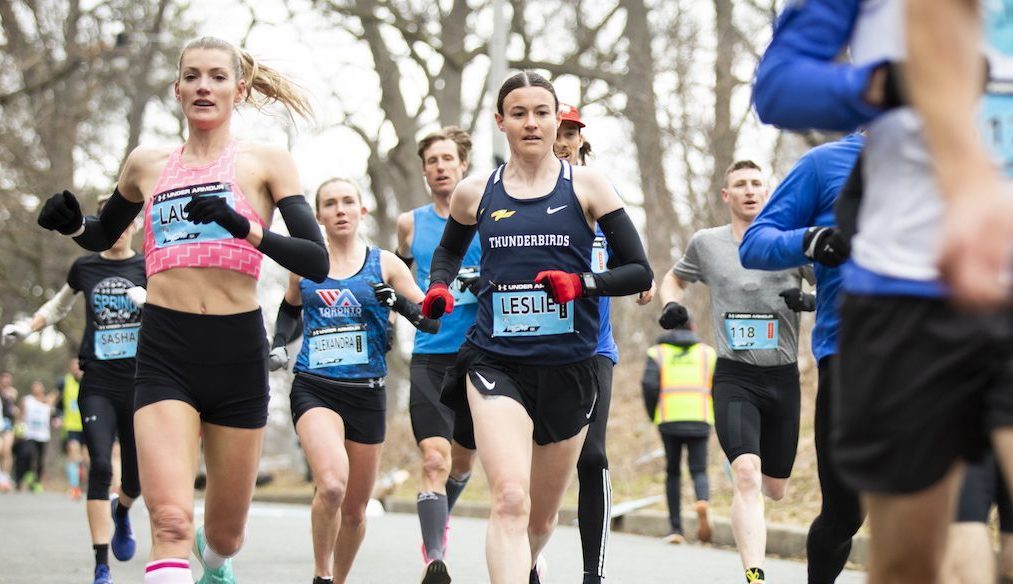How important is foot strength for runners?

Do you have a healthy relationship with your feet? For most runners, it’s easy to overlook what goes on below the knees–until something starts to hurt. But Toronto chiropodist and elite runner Laura Desjardins is on a mission to change that.
Founder of InStride Podiatry in Toronto, Desjardins blends her medical expertise with real-world running experience. She’s represented Team Canada at various international championships, worked with Olympic runners and alongside sports medicine physicians. Currently the chiropodist for the Toronto Raptors basketball team, she’s now spent a decade helping people understand just how much their feet matter.
“The foot takes on a lot of load, absorbing about three times your body weight,” Desjardins told Canadian Running. “We don’t necessarily strengthen the foot, but we ask a lot of it–which can cause these muscles to break down in their capacity to handle that load.”
The only real way to counter that, she says, is through strength training. Training the calf along with the feet can further help with strength.
Desjardins grew up in the small Georgian Bay town of Tiny, Ont., and dedicated her life to her passions for running and for helping people, studying kinesiology at Western University and earning her chiropody credentials at Toronto’s Michener Institute. Now, she continues to run with Monarch Athletics Club.

“Foot strength may not necessarily make you faster,” she says. “But when you get injured, that’s going to affect your ability to train and be consistent, which will puts you more at risk for certain injuries.” Plantar fasciitis, Achilles tendinopathy and metatarsalgia are three of the most common injuries she sees among runners.
How can runners tell if their feet are weak or undertrained?
Luckily, there are warning signs that something may not be right with your feet, the obvious ones being pain or discomfort. But Desjardins says the early signs could go unnoticed. “Your feet may start to collapse, your shoe sizes increases, or your foot spreads over time,” Desjardins says. “Bones begin to splay. The biggest tell is when your arch has collapsed and your foot starts to look deformed.”

Desjardins’ go-to strength moves
To avoid this, Desjardins recommends the following simple exercises to build foot strength:
“The best time to add these exercises is into your regular strength training program, or do them while watching TV,” Desjardins says. She also stresses the importance of looking at the full chain; weak glutes, for instance, can also affect your landing and put added stress on other joints.
Her advice? “Micro-dose your strength.” Even small additions like banded clamshells or hip extensions, can make a big difference over time.

Managing discomfort
Like any injury, managing foot weakness or discomfort is about finding a balance between being overly cautious and pushing through. “Continuing to run is important to keeping your foot used to that stress,” she says. “If you don’t use it, you lose it.” She suggests not stopping outright at the first sign of a niggle, but also not pushing through significant pain. If something doesn’t feel quite right, modify your volume or intensity; taping with a stiffer tape may also help. Consider seeing a chiropodist (preferably someone who is familiar with the specific demands of running).
Do shoes matter?
Desjardins notes that even with the recent trend toward higher-stack, more cushioned shoes, runners are still getting injured. She says it’s important to wear shoes that are designed for whatever type of running you’re doing, and not to always wear the same pair (or the same type of shoe) for every run. “For runners with irritation of the forefoot, I’d suggest higher-cushion shoes with a higher rocker and a lower drop of 4-6 mm,” she says. “For those with Achilles tendinopathy, a higher drop of 10-12 mm could help reduce that stress on the Achilles tendon.” Regardless of the type of shoe you’re wearing or what your training looks like, “A stronger foot means fewer injuries.”
Tired of max-cushion running shoes? A guide back to minimalism
For more information on foot health, visit BackInStride.com.




